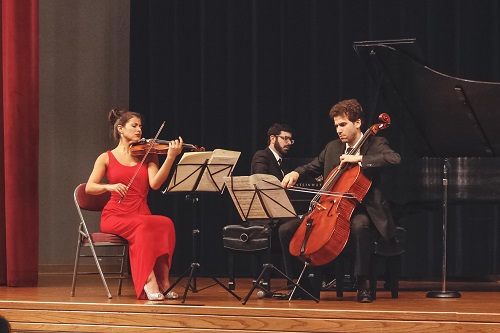 Canada Haydn, Chausson, Mendelssohn: Brown-Urioste-Canellakis Trio, Vancouver Playhouse, 20.3.2016. (GN)
Canada Haydn, Chausson, Mendelssohn: Brown-Urioste-Canellakis Trio, Vancouver Playhouse, 20.3.2016. (GN)

Haydn: Piano Trio No. 40 in F-sharp minor, Hob. XV: 26
Chausson: Piano Trio in G minor, Op. 3
Mendelssohn: Piano Trio No. 1 in D minor, Op. 49
This is the first time we have seen the young Brown-Urioste-Canellakis Trio, and what fine musicians they are. Pianist Michael Brown, winner of a 2015 Avery Fisher Career Grant, has lovely rounded tone and fluent articulation, and also happens to be a composer. Violinist Elena Urioste has sophistication, strength and great feeling in her playing and was recently named a BBC New Generation Artist. Nicholas Canellakis, a graduate of Curtis, is a cellist of precision and intelligence. They produce an enviably balanced, full sound, very clean in feeling, and are capable of moving to both an extreme refinement and a passionate earthiness. All these characteristics were displayed in this programme, which combined a late Haydn Trio and the famous Mendelssohn D minor with a work we rarely hear: the Chausson Trio, Op. 3.
I noted the balance and tonal solidity of the ensemble immediately in the Haydn F-sharp minor Trio XV: 26 (1795). The scale of the playing was just about perfect. Michael Brown’s pianism was also outstanding, having strong presence and moving the line of the music forward so transparently yet decisively. The group was always open to the composer’s robust wit but did not miss the more refined feelings either. They showed considerable emotional commitment in the great Adagio, which happens to be one of my favorite pieces of writing by Haydn, and serves as the slow movement of his exalted Symphony No. 102 in B-flat major.
The Chausson Trio, Op. 3 used to be regarded as an obscure work, but with well over ten recordings to date (including one by the Beaux Arts Trio 25 years ago) it is likely not these days. The fascination of the piece lies in its sharing of the ‘cyclical’ structure and melodramatic angst of Cesar Franck’s Piano Quintet. This is no accident: the Piano Quintet was written in 1879 and Chausson’s Trio followed quickly in 1881 ̶ while Chausson was studying with Franck. It is an enjoyable work to explore: many of its constructional devices and rhapsodic motives are attractive and find some depth, though other moments of bombast strike one as fairly empty. As with the Franck Quintet, a basic question is just how hard an ensemble should try to hit this work: there may be merits in covering up its moments of vulgarity with more delicacy. I don’t think this question would occur to a young ensemble: the current treatment was strong and committed to say the least.
The opening movement was impressive: full of rhapsodic flow, with strong surges of emotion (particularly from Urioste), but it still maintained full eloquence and balance. One scarcely noticed the academic quality of some of the construction. There was also a nicely bright-eyed sense of frolic and delight in the next movement, marked ‘Vite’. It was only in the slow movement, projected to maximum effect with razor-edge bite and sharpness, that the angst became somewhat ‘over the top’ and unremitting, at least to my taste. But there were still clear virtues in the playing: the ensemble held the line of the music well and the violinist certainly showed her distinctive ability to sustain a long full line – almost Oistrakh-like – and impart great feeling to it. There was possibly more carefree charm in the animated finale, yet one was left with the overall feeling that this was a passion-driven performance – and an impressive one of its type.
It was probably not the best idea to play the Mendelssohn D minor Trio after the Chausson, since the former requires a considerably more refined type of motion and lyrical sensibility. Again, the playing was distinguished but, perhaps expectedly, it tended to be rather high powered, not finding the gentle charming qualities, or innocent delight, in the writing. The performance did not get off to an auspicious start: Cannelakis’s initial cello statement was too broken by accents to set the full lyrical flow in place, and the romantic expression that followed was too fulsome. This ultimately burdened the opening Allegro, making it a little fragmented and overwrought. Conscientiousness marked the subsequent movements, yet some of the playing seemed hard-edged and the projection of the lyrical lines occasionally hinted more at Chausson’s fervour than Mendelssohn’s spring-like innocence. The power and drive of the finale, along with a full bravura finish, generated considerable excitement, but it would be difficult to say that the work came off as the endearing masterpiece that it is.
If I found this last interpretation relatively ‘unformed’, this has nothing to do with my estimation of the potential of this young ensemble, which is at the very highest level, or the enjoyment of this concert, which was considerable. The encore was a movement from Paul Schoenfield’s ‘Café Music’ for Piano Trio (1986), a lighter, jazzy piece, played with feeling.
Geoffrey Newman
Previously published in a slightly different form on http://www.vanclassicalmusic.com.